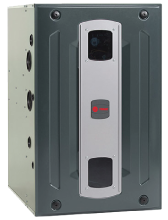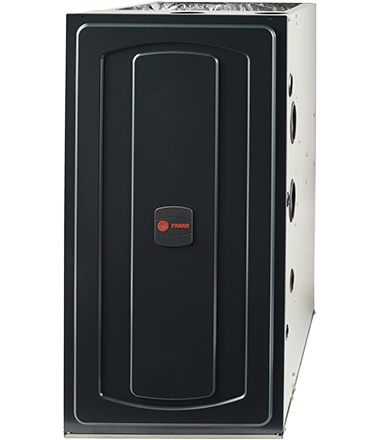Gas Furnaces
A Warmer Winter
Ohio winters can be brutally cold. Let DK Heating & Sons keep you and your family warm during the winter season. Our broad selection of high-efficiency gas furnaces will not only provide you with unwavering comfort, but will also help you to save on your monthly energy expenses.


PREMIUM
S9V2 Variable Speed Gas Furnace
Comfort Technologies:
Our quietest furnace combines high energy efficiency with noise reducing technology for complete comfort. Add Trane CleanEffects™ Air Cleaner to your system for advanced air filtration.
Energy Star:
Yes
AFUE:
Up to 97% AFUE
Fan Motor:
Patented variable speed Vortica™ II blower uses less electricity, meaning higher efficiency for your home.
Gas Valve:
Two-stage gas valve adjusts fuel use based on your heating demand, providing more comfort with lower, longer run times and reduced temperature swings.
Parts Warranty:
10-Year Parts Limited Warranty
Heat Exchanger Warranty:
Lifetime Heat Exchanger Limited Warranty


ADVANCED
S9X2 Two-Stage Gas Furnace
Comfort Technologies:
The new S9X2 furnace offers two stages of gas heat for comfort in cold weather, and a CTM blower for maximum efficiency in warm weather, while maintaining the quality and reliability that Trane is known for.
Energy Star:
Yes
AFUE:
Up to 96% AFUE
Fan Motor:
ECM constant torque, high-efficiency blower motor.
Gas Valve:
Two-stage gas valve adjusts fuel use based on your heating demand, providing more comfort with lower, longer run times and reduced temperature swings.
Parts Warranty:
10-Year Parts Limited Warranty
Heat Exchanger Warranty:
Lifetime Heat Exchanger Limited Warranty


STANDARD
S9X1 Two-Stage Gas Furnace
Comfort Technologies:
Trane’s most affordable high energy efficient furnace that keeps your home and your budget comfortable.
Energy Star:
Yes
AFUE:
Up to 96% AFUE
Fan Motor:
ECM constant torque, high-efficiency blower motor.
Gas Valve:
Single-stage gas valve.
Parts Warranty:
10-Year Parts Limited Warranty
Heat Exchanger Warranty:
Lifetime Heat Exchanger Limited Warranty
Getting to Know Your Gas Furnace
90%+ Furnaces
A 90% plus furnace has two heat exchangers (a primary and a secondary) and are commonly called “condensing” furnaces. These furnaces are capable of extracting at least 92% of the heat from combustion and transferring it into your home. The term “90% plus” means just that, the furnace’s efficiency rating is above 90%. For each $1.00 of natural gas that the furnace uses, at least 92% (or $.92) is used to actually heat your home and the remaining 8% (or $.08) is vented to the outside through the sidewall or roof of your home using a PVC plastic pipe.
80% Furnaces
An 80% efficiency furnace has only one (or primary) heat exchanger and extracts at least 80% of the energy from the combustion process and transferring it into your home. Simply stated, for each $1.00 of natural gas or propane that is used by the furnace, at least 80% (or $.80) is actually used to heat your home. The remaining 20% (or $.20) is vented out through your chimney or flue pipe.
Modulating
Modulating gas furnaces are very high efficiency furnaces, usually 95% and higher. These models also use computer technology along with special gas valves to control the burner output. The burner levels on these models operate at varying levels hence the term “modulating”. When the room thermostat calls for heat, the furnace fires and starts operating at a “medium” level. The furnace operates at this level for a short period and as the temperature gets closer to the set point, the furnace “modulates” to the lowest level until the thermostat is satisfied. In cases where the thermostat is set significantly higher than the room temperature or the heat demand is high, the furnace will operate on the highest stage in order to warm the home up as fast as possible.
Two-Stage
Two-stage gas furnaces are available in both 80% and 90% efficiencies. However, two-stage furnaces use a microprocessor along with a two-stage gas valve to control the burners at a high or low rate, depending on the heat demand. When the outside temperatures are moderate, the burners operate at a lower, more efficient rate. If the outside temperatures are very cold, then the furnace will operate at the higher rate in order to keep up with the heating demand.
Single-Stage
Single-stage gas furnaces are available in both 80% and 90% efficiencies. The term “single-stage” means simply that the furnace’s burners fire at one fixed heating level. When the thermostat tells the furnace to heat, the gas valve opens and the burner flame ignites. When the thermostat is satisfied, the burners shut-off.
ECM Variable-Speed Motor
Unlike conventional PSC motors which are designed to run at 1 speed, an ECM variable-speed motor can run at a wide range of speeds to precisely deliver the exact airflow required to heat or cool the home to temperature called for by the thermostat. Typically, an ECM motor will turn on and gradually increase the speed of the fan as more air is called for, and decrease the speed as target temperature is close to being met. Additionally, variable-speed motors are much quieter than conventional motors and improve air circulation which results in reduced temperature swings, greater indoor comfort and significant energy savings.Unlike conventional PSC motors which are designed to run at 1 speed, an ECM variable-speed motor can run at a wide range of speeds to precisely deliver the exact airflow required to heat or cool the home to temperature called for by the thermostat. Typically, an ECM motor will turn on and gradually increase the speed of the fan as more air is called for, and decrease the speed as target temperature is close to being met. Additionally, variable-speed motors are much quieter than conventional motors and improve air circulation which results in reduced temperature swings, greater indoor comfort and significant energy savings.
PSC Motor
A PSC motor is designed to more simply turn on and turn off. The output of a PSC motor is isn’t controllable and it has no intermediate speeds, which means it’s either running at it’s full output or isn’t running at all.
